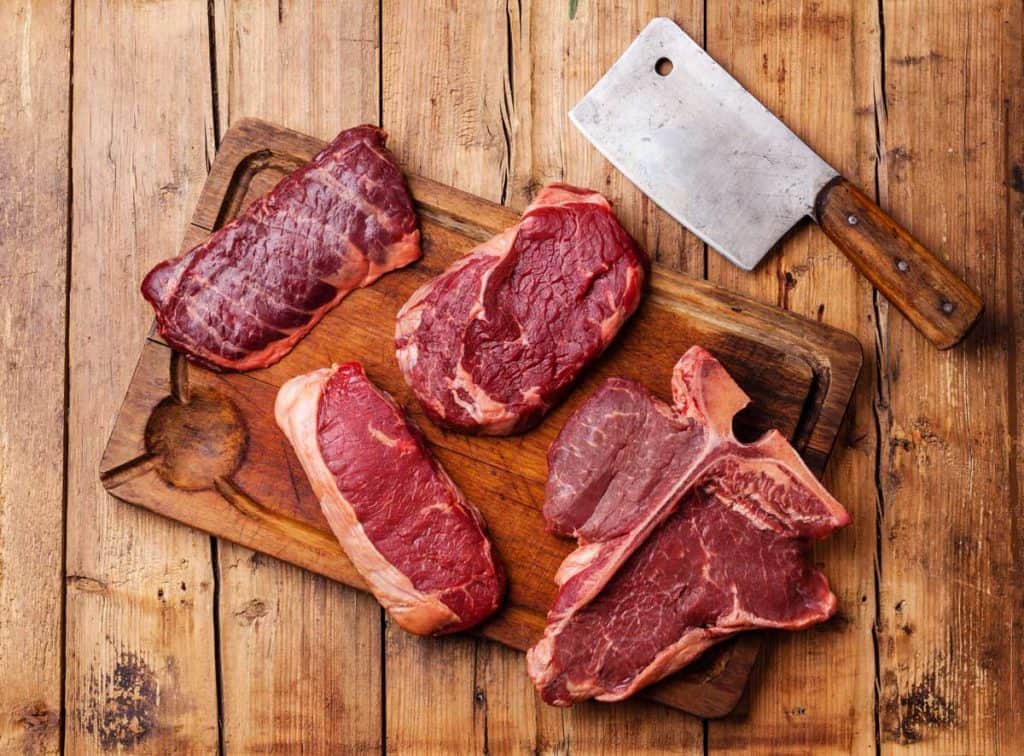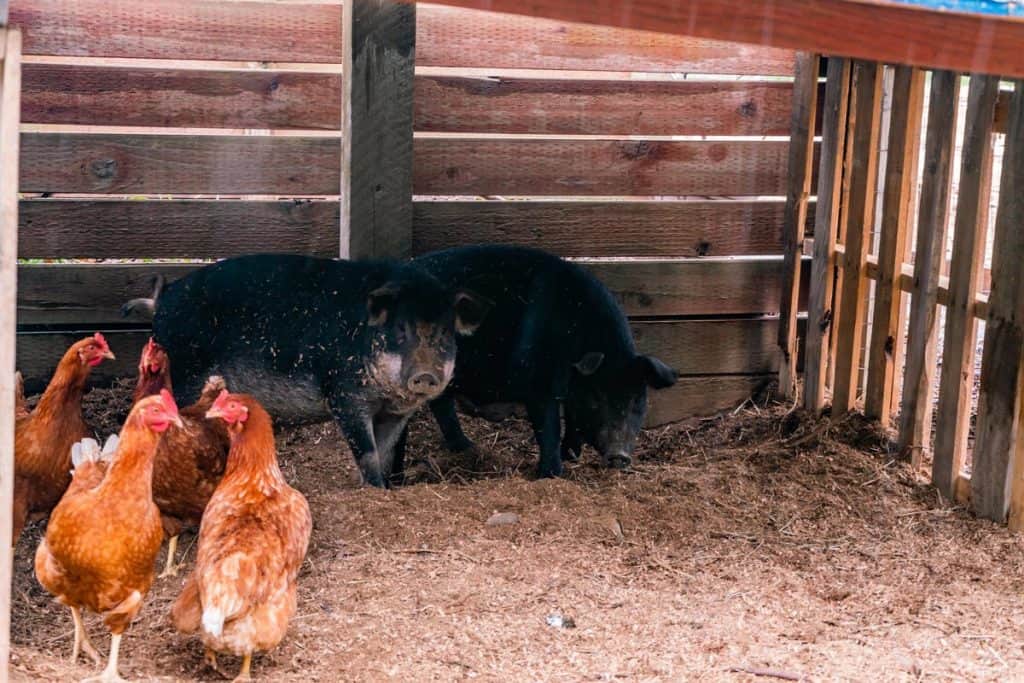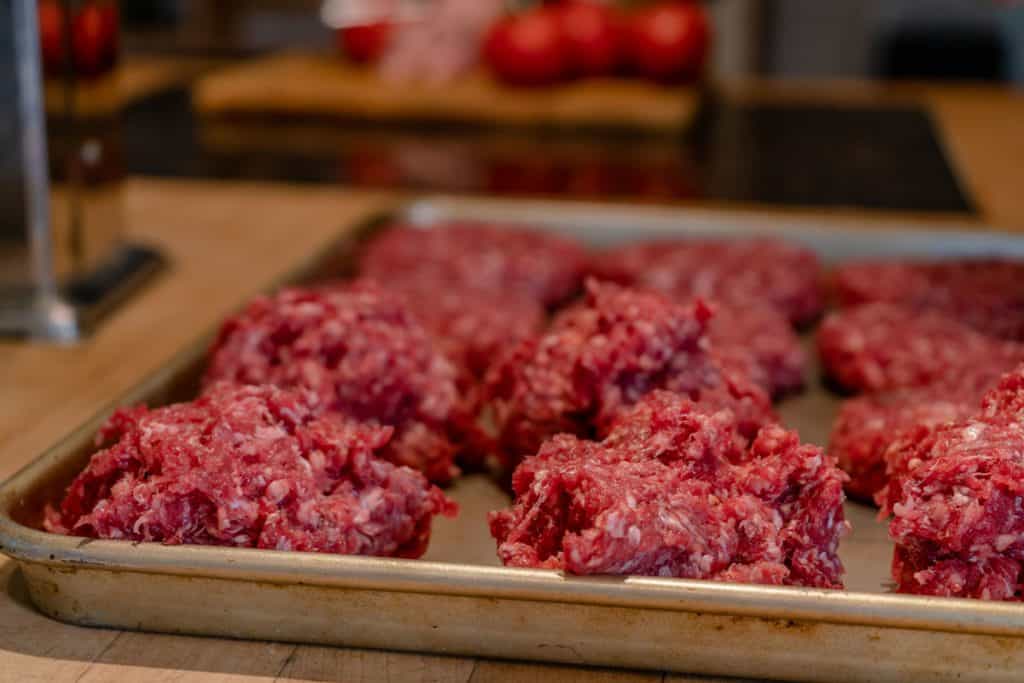Raising or buying locally-raised meat is a fantastic way to bring healthy, high-quality food into your home without buying it at expensive retail prices. But there are quite a few things you should know before butcher day to ensure you get the most out of your meat.

We’re big proponents of raising your own meat. We not only like to know how the animals were treated, but we also like to be able to control the food our animals get to ensure the meat is as healthy as possible for us to consume.
This includes feeding them non-GMO feed, as well as grass-feeding and grass-finishing our beef.
Raising your own animals not only allows you to control these factors, but it also allows you to control what happens to the animal on butcher day and, in turn, the cuts of meat you’ll bring home to store.
Here are some of our best tips for choosing a butcher, plus everything you need to know before butcher day, as well as what to expect on butcher day.
Know Your Butcher
Our best advice, unless you’re going to slaughter and butcher your animals yourself, is to get to know your butcher and all their practices.
Many butchers have different ways of doing things, so get to know them and familiarize yourself with the way they handle your meat and how they will work with you to ensure you get a quality job done, the way you want it done!
It’s also really important to get a butcher willing to work with you and answer your questions. Many butchers are busy, and in the past year, we know in our area the butchers have been at full capacity every month.
But a good butcher should still spend time with you over the phone (or in person) to answer any questions you might have about their practices.

Where Will They Slaughter?
If you’re raising your own cow, pig, lamb, etc., it’s important to know whether you need to get your animal to the butcher shop, or whether they have a traveling operation that they’ll come butcher on your property.
This really depends on what you have available in your area. Not all butchers have a mobile operation, meaning they travel to the farm, slaughter your animal, then transport it back to the butchering facility.
Some butchers require you to get your own animal to the butcher where they both slaughter and butcher the meat up for you. This is one question that’s good to get figured out well ahead of time.
When hiring a butcher we prefer to slaughter on site. This may cost a little more, but it is less work for us, and much less stress on the animal, which results in better quality meat. When animals are highly stressed they release hormones that affect the tenderness and even taste of the meat.
If you don’t have that option and have to take your animal in to be slaughtered, one thing you can do during the animal’s life is to load it up and take it for a drive semi-regularly and always reward it with something special when you unload. Yep, this is a bit of extra work, but it will teach your animals not to fear the loading and transport process, making the experience better for them and their meat better for you!

Make Sure It’s Your Meat
Some larger (and even smaller) butchering facilities will mix cuts of beef together until they have a large enough quantity to grind up for ground beef.
If you’re going through the trouble to raise your own grass-fed and grass-finished beef, you don’t want your high quality product getting mixed with someone’s product who didn’t follow the same feeding/grazing practices.
Really checking into the reputation of the butcher and talking to long time existing clients of theirs will give you assurance on this.
Get a Butcher Willing to Work WITH You
There are so many ways to get your meat cut up, and not everyone likes it the same way.
Some butchers have one way of butchering meat and don’t allow you to tailor it much. Others will call you when they’re about ready to butcher with a list of questions on how you want your meat cut up (weight, the thickness of steaks, cuts, packaging specifications, etc.).
This is all good information to know BEFORE getting that phone call!

What Cuts of Meat Should I Get?
Most butchers will have a standard cut list and if you have no idea what you want to be done with your meat, this is a safe way to go. You can then take notes on what got used up first, and what cuts were left at the end and edit this list moving forward to better tailor it to your needs.
You may also find that this differs from year to year depending on the size of your family, the age of your kids, whether you’re cooking to have leftovers, etc.
Beyond the cuts of meat you’d like to get, your butcher will also ask you about thickness of steaks, number of steaks per package, how much ground beef you’d like per tube, etc.
Think about how your family uses these items to know the quantity you’d like. Many butchers are great at their jobs, and if you share the size of your family and about how much you eat per meal, they can usually give some pretty general guidelines to help you make these decisions.
Again, be sure you make notes throughout the year as you’re consuming your meat. Did you get large enough packages of meat? Do you like the thickness of the cuts you got? All this info will help determine what you do next time.

Make Known What You Want
Certain parts of the animal, will be disposed of at the time of slaughter (brain, tongue, cheeks), whereas other parts of the animal will get tossed at the butchering facility unless otherwise requested.
You need to know who to communicate to if you want specific parts of the animal, and having good communication about this will ensure none of your animal gets tossed. Items like the fat, bones, liver, kidneys, heart, tongue, cheeks, oxtail, etc. will all need to be requested ahead of time to ensure you receive them.
This is a great opportunity to try traditional whole foods and some of the healthiest cuts of meat. Use beef tongue to make incredibly delicious Fajitas de Lengua, use the bones to make bone broth, or the fat for rendering lard.
Fat (Inner Fat and Back Fat)
It’s important to raise fat sources on your homestead to increase self-sufficiency and resilience.
Leaf Lard or Inner Fat
If you plan on doing any rendering of your fat, make sure you request that the “inner fat” be separated out from back fat other fat that’s gathered from the animal as these are used differently.
Learn how to render your own lard here.
On a pig, this inner fat is called “leaf lard” once it’s rendered and it’s what you want to use for all your baking, pastries, pies, etc. On beef, this is called tallow.
Back Fat
The inner fat needs to be separated out from the “back fat” because they have very different flavor profiles.
Backfat is better used for cooking vegetables, meats or even used to make candles or as a leather conditioner.
No matter what kind of meat you’re getting, if you’re planning to render it down, request that the butcher grind the fat before packaging it up. This will make the rendering process much faster and easier. Even if your butcher charges you a few extra bucks for this process, trust us when we say it’s worth every penny!
Bones
You can also request your bones be cut up into small, 3-inch pieces that are useable for rendering, making into stock, or for the animals.
Offal and Specialty Cuts
Offal is any part of the animal that is not muscle meat or bones, like organ meat. You may not know exactly how to use it yet, but it’s food you’ve paid for so you may as well bring it home and start experimenting with how to prepare it.
Here are the nutritional benefits of organ meats and some cooking tips to help you get started. Making your own homemade organ meat seasoning is a good place to start.
Who Pays the Butcher?
Most often, you are responsible for both the kill fee and the butchering fees. You may pay two or three separate people if you didn’t raise the animal yourself. There may be one amount that goes to the farmer, one fee for the slaughter, and one fee for the butchering.
Storage Space
So how much storage space, or more accurately, freezer space will you need to store your meat? The answer to this question varies greatly not only depending on the type of animal you’re butchering, but on the size of the animal and how you have it cut up.
A grass-fed, grass-finished cow will be about 400-500 lbs. hanging weight. Whereas a conventionally raised cow can be upwards of 700-800 lbs. hanging weight. Pigs and sheep are obviously much less.
So you see this answer isn’t as straightforward as we’d like it to be. But, generally speaking, we can fit one grass-fed cow and one or two lambs into a 6 ft. chest freezer (which is about 22-24 cubit square feet).
You can free up freezer space by pressure canning some of the meat too. Here are tutorials on canning meat, canning ground beef, and canning beef stew.
Storage Methods
When you bring home a whole cow all at once, how do you organize your freezer so all the liver isn’t at the top?
There are a few tips we’ve picked up over the years:
- Ditch the storage bins and containers – these just tend to take up space and don’t help when organizing a whole cow. Freezers with little plastic walls for dividing space can be useful, however.
- Stack like-items vertically – Try stacking all your ground beef vertically on one side of your freezer so you know right where it is. The same with steaks and roasts, etc.
- Know when you’ll use specialty cuts – if you know you’ll use a leg of lamb near Easter, then you can put those down toward the bottom of the freezer because you know you won’t need them for close to a year (or however soon it is when you butcher your animal).
It’s true that raising your own meat, or buying in bulk from a local farmer is going to save you a lot of money when it comes to stocking your freezer and feeding your family.
Knowing what to expect before butchering day should alleviate much unnecessary stress and uncertainty.
Above all else, be proud of the step you’re making toward more self-sufficiency and less reliance on the grocery stores.
If you are just starting with raising your own animals or buying from a local producer, we recommend you start with having your meat cut up for a few years by a trusted butcher. Eventually, if you are so minded, you may want to start processing your own meat in order to save more $$ and control the outcome.


















